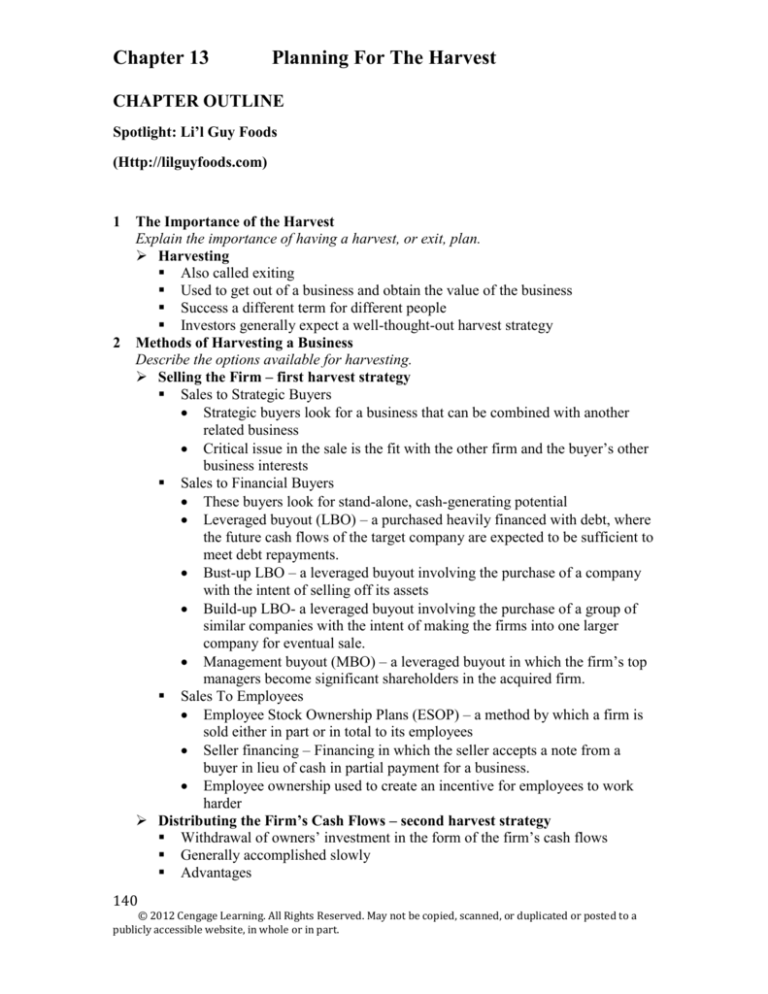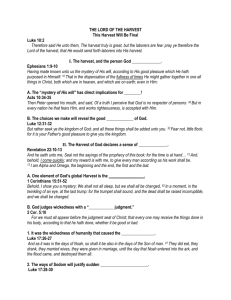
Chapter 13
Planning For The Harvest
CHAPTER OUTLINE
Spotlight: Li’l Guy Foods
(Http://lilguyfoods.com)
1 The Importance of the Harvest
Explain the importance of having a harvest, or exit, plan.
Harvesting
Also called exiting
Used to get out of a business and obtain the value of the business
Success a different term for different people
Investors generally expect a well-thought-out harvest strategy
2 Methods of Harvesting a Business
Describe the options available for harvesting.
Selling the Firm – first harvest strategy
Sales to Strategic Buyers
Strategic buyers look for a business that can be combined with another
related business
Critical issue in the sale is the fit with the other firm and the buyer’s other
business interests
Sales to Financial Buyers
These buyers look for stand-alone, cash-generating potential
Leveraged buyout (LBO) – a purchased heavily financed with debt, where
the future cash flows of the target company are expected to be sufficient to
meet debt repayments.
Bust-up LBO – a leveraged buyout involving the purchase of a company
with the intent of selling off its assets
Build-up LBO- a leveraged buyout involving the purchase of a group of
similar companies with the intent of making the firms into one larger
company for eventual sale.
Management buyout (MBO) – a leveraged buyout in which the firm’s top
managers become significant shareholders in the acquired firm.
Sales To Employees
Employee Stock Ownership Plans (ESOP) – a method by which a firm is
sold either in part or in total to its employees
Seller financing – Financing in which the seller accepts a note from a
buyer in lieu of cash in partial payment for a business.
Employee ownership used to create an incentive for employees to work
harder
Distributing the Firm’s Cash Flows – second harvest strategy
Withdrawal of owners’ investment in the form of the firm’s cash flows
Generally accomplished slowly
Advantages
140
© 2012 Cengage Learning. All Rights Reserved. May not be copied, scanned, or duplicated or posted to a
publicly accessible website, in whole or in part.
Chapter 13
Planning For The Harvest
Owners retain control of business while harvesting
Owners do not need to find a buyer or incur the expenses associated with
completing a sale of the business
Disadvantages
Reducing reinvestment negates possible growth and results in lost value
creation
Tax disadvantages to an orderly liquidation
This method may require too much patience and therefore be destined to fail
Double taxation – taxation o f income that occurs twice- first as corporate
earnings and then as stockholder dividends.
Initial Public Offering (IPO) – third harvest strategy
Basically selling stock in the business
Reasons for Going Public
Company offers its stock to the general public
Benefits
Signals to investors that firm is a quality business and will likely
perform well in future
Stock traded publicly has access to more investors when capital
needed to grow the business
Helps create ongoing interest in company and continued development
Publicly traded stock more attractive to key personnel whose incentive
pay includes the firm’s stock
The IPO Process
Steps in the IPO process
Consider the shift in power that occurs during the process of an IPO
Understand the investment banker’s motivations in IPO process
Consider costs of running a publicly traded company along with the initial
costs of the IPO
Private Placement – fourth harvest strategy
Described briefly in Chapter 12
Effective for family-owned businesses that need to transfer ownership to next
generation
Three goals
Liquidity (cash) for the selling family members
Continued financing for company’s future growth
Desire of buying generation to maintain control of the firm
3 Firm Valuation and the Harvest
Explain the issues in valuing a firm that is being harvested and deciding on the
method of payment
The Harvest Value
Opportunity cost of funds – the rate of return that could be earned on a
investment of similar risk
Check Appendix B at end of book for specific approaches to and methods for
valuing a company
Method of Payment
141
© 2012 Cengage Learning. All Rights Reserved. May not be copied, scanned, or duplicated or posted to a
publicly accessible website, in whole or in part.
Chapter 13
Planning For The Harvest
When selling there are three basic choices
Sell the firm’s assets
Sell its stock
Merge with the buyer who owns another company
Exiting entrepreneur
Stock allow gain on the sale to be a capital gain, resulting in lower taxes
Buyer may prefer to purchase assets rather than company stock
4 Developing an Effective Harvest Plan
Provide advice on developing an effective harvest plan.
Anticipate the Harvest
Must be planned or may distract form day-to-day affairs causing loss of
managerial focus and momentum
Uncertainties may lower employee morale
Investors always concerned about how to exit
IPO had requirements not required of a privately held firm
Expect Conflict—Emotional and Cultural
Buying a company and selling a company are very different
Buyer can be unemotional and detached
Seller likely to be more concerned about nonfinancial considerations
Qualities that make successful entrepreneurs may make them difficult as
employees
Get Good Advice
Harvesting not like day-to-day activities since is happens many fewer times
Professional advice vital
Also talk to other entrepreneurs
Understand What Motivates You
Harvesting an emotional experience
Difficult to walk away from business, employees, and clients
Personal identify tied to business
5 What’s Next?
Since entrepreneurs are purpose-driven, it is important that they find meaning in
life following exit.
For many, giving back to the community and charitable causes may bring
meaning and purpose to post-exit life.
ANSWERS TO END-OF-CHAPTER DISCUSSION QUESTIONS
1.
Explain what is meant by the term harvesting. What is involved in harvesting
an investment in a privately held firm?
Harvesting is the method entrepreneurs and investors use to exit a business and,
hopefully, reap the value of their investment in the firm. For the privatelyowned company, there are four basic ways to harvest investment. First, the
owners can simply sell the firm. This strategy is most likely to be used when
142
© 2012 Cengage Learning. All Rights Reserved. May not be copied, scanned, or duplicated or posted to a
publicly accessible website, in whole or in part.
Chapter 13
Planning For The Harvest
the entrepreneur has estate planning needs or a desire to diversify his or her
portfolio of investments. Second, the owner(s) can release the firm’s free cash
flows, using one of the options available to achieve this. Third, stock in the
company can be offered to the public in an initial public offering (IPO). Finally,
the owners can extract some of the value of the firm via private equity
placements.
2.
Why should an owner of a company plan for eventually harvesting his or her
company?
There are several good reasons for planning in advance for the exit. For
example, when a company changes hands, employees face considerable
uncertainty and morale often suffers. This has a negative effect on the
company's performance. A well-planned exit can minimize dysfunctional
employee behavior and turnover, which helps maintain stable performance
during the transition (which is also important to the exiting entrepreneur if
he/she receives all or some payment in the form of stock in the exited company).
Having an exit plan can also guide the entrepreneur in positioning the company
for optimal value in the years prior to the sale and ensure a smooth transition to
public ownership (in the case of an IPO). Finally, exit planning can prepare the
company for rapid sale if a window for such an opportunity should open and
close quickly.
3.
Contrast a sale to a strategic buyer with one to a financial buyer.
These two acquisitions differ primarily in terms of the goals of the buyer. In a
strategic acquisition, the buyer is interested in gaining synergies from the fit of
the target acquisition with current holdings. In contrast, the financial
acquisition looks primarily to the stand-alone potential for cash generation as
the source of its value.
4.
Explain the term leveraged buyout. How is a leveraged buyout different from
a management buyout?
Leveraged buyouts are acquisitions that rely on heavy debt financing. If the
LBO includes the firm’s top management as significant shareholders in the
acquired firm, then it is referred to as a management buyout. Thus, a
management buyout is a type of LBO.
5.
Distinguish between bust-up LBOs and build-up LBOs.
During the 1980s, the leveraged buyout (which is a financial acquisition
involving a very high level of debt financing) became synonymous with the
bust-up LBO. This strategy involves owners who pay the debt down rapidly by
selling off the acquired firm's assets. The build-up LBO replaced bust-up LBOs
© 2012 Cengage Learning. All Rights Reserved. May not be copied, scanned, or duplicated or posted to a
publicly accessible website, in whole or in part.
143
Chapter 13
Planning For The Harvest
in the 1990s. The build-up LBO involves the integration of smaller acquisitions
into a larger enterprise that can then be taken public in the IPO.
6.
7.
What is the primary purpose of an initial public offering (IPO)? How does an
IPO relate to harvest?
The initial public offering refers to a strategy of making available the stock of
a privately-owned company to any interested investor. The primary purpose of
an IPO is to raise additional equity capital to finance company growth, but it
can also serve as an additional strategy for harvesting the investment of owners.
Once the company’s stock is publicly traded, the pre-offering owners can cash
out eventually by selling their stock on the market.
Why might an entrepreneur find going public a frustrating process?
Going public does offer liquidity and eventual harvest benefits to a company.
However, this move also brings significant frustrations, such as facing the
scrutiny of public-market investors and dealing with investment bankers (who
have their own unique interests in such an offering). Perhaps as frustrating as
any other feature of the process, the IPO process involves a shift in control from
firm management (including the entrepreneur) to the investment banker.
8.
What determines whether a firm has value to a prospective purchaser?
A firm’s value is based on its return on invested capital relative to the investors’
opportunity cost of funds, which is the rate of return that could be earned on an
investment of similar risk. If the return on the invested capital for the purchaser
is greater than the opportunity cost of the money invested, value will be created.
Otherwise, value will be destroyed; that is, for every dollar invested, it will be
worth less than a dollar.
Growing a venture to the point of diminishing returns and then selling it to
others who can carry it to the next level is a proven way to create value. In this
case, the purchaser is able to do more with the business than the seller, and is
thereby adding value.
As described in the appendix at the end of the book on Firm Valuation, buyers
and sellers frequently base the harvest value of a firm on a multiple of earnings.
For instance, a company might value at five times its earnings. (An example of
an entrepreneur, Robert Hall, who sold his firm for a multiple of earnings, is
provided in the appendix.)
9.
What problems can occur when an entrepreneur sells a firm but continues in
the management of the company?
Entrepreneurs with experience in acquisitions often find that they enjoy buying
other companies more than being bought. Going from being the boss to taking
orders from the new owners, entrepreneurs often do not make good employees.
144
© 2012 Cengage Learning. All Rights Reserved. May not be copied, scanned, or duplicated or posted to a
publicly accessible website, in whole or in part.
Chapter 13
Planning For The Harvest
The very qualities that made them successful entrepreneurs can make it difficult
for them to work under the new owner(s), which often leads to their
disillusionment and premature resignation. A clash between the culture of the
company before and the new corporate culture can also lead to intense feelings
of disappointment.
10.
How may harvesting a firm affect an entrepreneur's personal identity?
Entrepreneurs who leave their business often become disillusioned when they
come to understand how much their personal identity was intertwined with their
business. Some have done less than rational things after cashing out (for
example, buying exotic cars and expensive houses that they did not need), and
this can compound any regrets that follow the exit. Finally, entrepreneurs tend
to be very purpose-driven, so they may need to adjust their lives to derive
meaning from the post-exit world. This might very well mean giving back to
the community or joining in the work of charitable cause(s).
COMMENTS ON CHAPTER “YOU MAKE THE CALL” SITUATIONS
Situation 1
1. Describe the scenario as presented In the Spotlight at the beginning of the
chapter.
The owner’s of Li’l Guy Foods, a three-generation family-ownned Mexicanfood manufacturing business were faced with reduced margins to an increase
in food and plastic packaging costs. Understandably, outside investors were
nervous. During this time Li’L Guy Foods was approached with an offer of
acquisition by one of their larger competitor’s, Tortilla King. Tortilla King
saw this acquisition as a way to reduce competition and increase market share.
The two companies agreed on an acquisition agreement and approached
Tortilla Kings bank for financing. Just as the deal was about to close, the bank
pulled back and the two companies were left to find a way to finance the deal
on their own. Li’l Guy Foods agreed to finance the purchase with a five-year
repayment term with an interest arte of 8%. This was not ideal for either
company but a result of the increased lending restrictions.
2. What would be the reasons for and against Christina and David Sloan
working for Tortilla King?
Some reasons for:
Smoother transfer of ownership between the two companies
Increased likelihood of success for all parties involved. With the
Sloan’s having a five year purchase agreement at stake, they want to
ensure the success of this acquisition.
© 2012 Cengage Learning. All Rights Reserved. May not be copied, scanned, or duplicated or posted to a
publicly accessible website, in whole or in part.
145
Chapter 13
Planning For The Harvest
Some reasons against:
Conflict could arise between the Sloan’s and the management of
Tortilla King due to differences in managerial styles.
Either party may not want to be so closely invested with the either.
3. What advice would you offer the Sloans?
The Sloan’s need to guard their investment so they need to be agreeable to this
transition process. The should establish boundaries up front. State a time frame for
this transitionary period. Identify their role in the company; clearly state their
responsibilities. Establish and end date. If their services are needed beyond that,
negotiate, up-front, a compensation package.
Situation 2
1. Do you agree with the Bonneaus’ decision to sell? Why or why not?
The Bonneaus were becoming less and less interested in the business. It was
no longer fun for them, which suggested that they needed a change. Also, it
was time to sell so that someone else with deeper pockets could consolidate
several firms in the same business and gain power in dealing with the larger
customers, such as Wal-Mart.
2. Why did the buyers retain Ed as a consultant? (In answering this question,
you might consider the quote by Bonneau in the chapter.)
It was intended as a de facto non-compete agreement.
3. Do you see any problem with having the Bonneaus' son-in-law become the
new chief operating officer?
It placed Bonneau and his son-in-law in an awkward position. The son-in-law
was having to negotiate from the perspective of the new chief operating officer
after the sale, so he had certain needs. Bonneau, on the other hand, was
negotiating from the perspective of someone who would be exiting the firm.
There were some conflicts of interest as a result.
Situation 3
1. Do you agree that the entrepreneur’s company is not sellable?
146
© 2012 Cengage Learning. All Rights Reserved. May not be copied, scanned, or duplicated or posted to a
publicly accessible website, in whole or in part.
Chapter 13
Planning For The Harvest
Lipper understood that there would be some emotional stress after selling his
firm, but he also understood that a time might come when someone else could
do more with the business than he was able to do. Thus, his emotions were
balanced with the reality of the situation. Siverman avoided any emotional
problems by having other priorities that gave meaning to her life apart from the
company. The golfer clearly was emotionally distressed by not having other
interests that made a difference to someone. Golfing did not provide an
adequate foundation for a positive self-image.
2. Are there any other options for the entrepreneur besides selling his business?
A person who knows who he/she is and what is important to him/her will be
more likely to have positive feelings about cashing out after the transaction is
complete.
SUGGESTED SOLUTION TO CASE 13: GREENWOOD DAIRIES
1. What type of buyer do you believe purchased Greenwood Dairies? What might
have been its reasons for buying the firm?
These were financial buyers who were conducting a sort of Build-Up-LBO. The
company had positive cash flows and they were able to take advantage of this by
consolidating the business and merging the operations with an existing cheese
factory. Indeed, the investment bankers were capitalizing on scales of efficiency.
2. What advice would you have given the Greenwoods when they were in the
process of deciding to sell the business?
The Greenwoods appear to have structured a wise business deal. David, though
was too attached to the company. He needed to sell the business and be done with
it or not sell it at all. His attachment to the company caused him great remorse.
Staying on as a consultant is beneficial to both parties but David had to let go of
the company and detach himself from the emotional draw.
3. Given their age, was it a mistake for the Greenwoods to rebuy the dairy?
Maybe or maybe not. Age isn't a factor. David certainly has the drive and
determination to make the company a success. He has a proven track-record and
is well established in the community. Peter Drucker was a strong proponent of
working until one couldn't physically work any longer. Drucker firmly believed
this and he himself worked up until he was 94 years old. For David, this makes
sense although he has to be sensitive to Rose's needs. Together they should
structure a work schedule so that David's time is not completely absorbed by the
company.
147
© 2012 Cengage Learning. All Rights Reserved. May not be copied, scanned, or duplicated or posted to a
publicly accessible website, in whole or in part.
Chapter 13
4.
Planning For The Harvest
What do you think should have been the Greenwoods’ goal when buying back
the business?
The goal should be to rebuild the company and make it financially healthy.
Establish some sales and growth goals. Some profit goals and some long-term
management goals. David seems to enjoy the challenge of turning the business
around. Once that happens, he should have some idea of what his role will be in
the company. He may perhaps want to sell his ownership share to his partner and
stay on as a consultant, thereby alleviating him from the demands of the daily
operations of the factory.
148
© 2012 Cengage Learning. All Rights Reserved. May not be copied, scanned, or duplicated or posted to a
publicly accessible website, in whole or in part.










